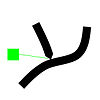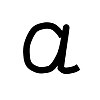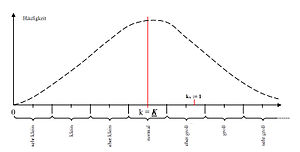Complexity of handwriting
Determining the complexity of manuscripts with the help of a number of countable parameters allows an a priori assessment of the yield of findings in comparative tests of the authenticity or the identity of the author of handwritten scripts.
A priori criteria
It should be noted that, in addition to the complexity , other criteria such as scope and diversity , self- imprinting and variability as well as the timeliness of the comparative writing material to the writing performance in question can provide initial indications as to whether the probability scale on which the end result is based must be limited upwards or whether it is fully exhausted can be. The expert's result depends primarily on the quality, but also on the quantity of the findings: the more findings that are essential for specific hypotheses can be objectified, the more valid the expert's result will be.
So far, the complexity of manuscripts has only been marginally taken into account in forensic reports , as they have only been subjected to a " prima vista " assessment by the handwriting expert . A higher quality use of the "complexity" criterion is described below.
Complexity vs. validity
The yield of results depends on the complexity k and the length L of the writing performance to be examined. With the relative complexity defined below - independent of L - a measure for the yield of findings can be defined as
- E = k * L .
The complexity is usually estimated on a coarse ordinal scale with only a few levels (very low ... medium ... very high). If one excludes highly disturbed fonts, it can be assumed that the following proportionality exists as a first approximation:
- E = k * L ~ validity .
The appraiser can rarely witness the actual process of creating the lettering during the writing process. In most cases, the writing product is ready. Accordingly, only the purely formal complexity of the finished lettering can be observed, but not the complexity of the underlying control processes (see below).
parameter
Similar to the line tension, when assessing the complexity, the image of a rope that has been laid down in a more or less orderly manner and thereby forms more complex or simpler patterns can be helpful. It may be twisted, it may form loops, crisscrossed, chopped up and made up of several pieces. - Analogously, the parameters described in more detail below can be used to describe the complexity of lettering.
Line crossings
A line crossing S is understood to mean the touching or overlapping superposition of two parts of the line produced one after the other in the course of a lettering in the plane of the lettering carrier.
| 1st order line crossings: | ||
| Line crossings 2nd order: | ||
| Line crossings of higher order: |
Interruptions in movement
An interruption of movement U within a lettering is to be understood as the lifting of the writing instrument from the writing device with subsequent resumption of the writing process - regardless of any line overlaps / touches.
| Example pattern: |
It is true that shorter movement elements are more easily accessible to the effectively and affectively used control of the writing process. But a distinction must be made as to whether the intended writing process or the finished writing product is to be assessed. Stringing together short movement elements may be easier, but the formal product itself may still be highly complex. (Compare a number of short pieces of rope that are artfully put together so that the impression of a coherent structure is created.) In this respect, recognizable interruptions in movement when determining the complexity of a lettering - despite easier control during the writing process - must also be counted.
Turning points
A turning point W is understood to mean the location of a change in the direction of rotation of one and the same lettering in the plane of the writing carrier from the clockwise direction of movement to the counterclockwise direction of movement and vice versa.
| Example pattern ( 1 ): | ||
| Turning points 2nd and higher order: | ||
| Origin of higher order turning points: | ||
| Turning points when movement is interrupted: |
- ( 1 ) The subtleties of the texture of the line (such as the movement advancements and reversals, tremors ...) are not taken into account.
- ( 2 ) In contrast to the two legs of an angle, the “legs” of the hairpin merge tangentially in the same direction at the junction .
particularities
The complexity of some special forms F are described only unsatisfactorily by the parameters given above. Special forms can also be counted.
| Unrolls: | |||
| Curls: | |||
| Other: | additionally: z. B. Underlining, extensions, etc. |
When crossing, the additional crossings result in an impermissible increase in complexity, as the following example shows:
| crossing crossings: |
The additional crossings are not counted; instead, only the number of crossings applies:
| Equivalent to: |
Practical examples
The following examples are for the parameters
the markings are set “by hand”.
Example 1: Signature "N. Volkhausen "
Writing system: Latin source alphabet; Font: based on Kurrent script
( 1 ) Standard lettering: The line crossings 2 (in the “k”) and 4 (in the “h”) are “real” line crossings with the immediately following base line. The line crossings 3 and 5 result from the opacity of the coat with the second stroke of the letters.
Example 2: Signature "Kamahn"
Writing system: Latin source alphabet; Font: based on block letters
- ( 1 ) Standard lettering: no spin change between lines of lines (e.g. "h" - "n". Depending on the font set, some character shapes vary considerably. (E.g. the "a" shape; see paragraph "Criticism") .
Mathematical determination of the complexity
The parameters mentioned above can be counted in most cases and lead to a mathematical approach to the description of the complexity of written structures. With little counting and time expenditure, a numerical value can be determined before each comparative examination, which reflects the complexity of the object to be examined with sufficient accuracy.
It is proposed to determine the absolute complexity of the lettering as the sum of the above parameters.
| example 1 | Example 2 | |
|---|---|---|
| self-embossed lettering: | K 1e = W + U + S + F = 13 + 3 + 6 + 0 = 22 | K 2e = W + U + S + F = 7 + 6 + 8 + 0 = 21 |
| Standard lettering: | K 1n = W + U + S + F = 26 + 4 + 7 + 0 = 37 | K 2n = W + U + S + F = 8 + 13 + 10 + 0 = 31 |
| relative complexity: | k 1 = 22/37 ≈ 0.59 | k 2 = 21/31 ≈ 0.68 |
You can see: The length of the lettering being examined does not matter because of the standardization.
In the case of text fonts, it is recommended to determine approximately three “typical” words (beginning - middle - end). If the complexity is determined not only from the respective questionable, but also from a comparative document, one receives a further evaluable comparative finding in addition to the usual findings.
In larger populations of writers, there are many lettering
- Mean k m and standard deviation SA
the respective relative complexities separately for signatures and text fonts in dependence on the writing system ( Latin alphabet / Sütterlin / ...) and of the Font ( Kurrent- / pressure / block letters ) calculate (s. u.). In any case, a
- Normal complexity as k n : = 1
Define in which the examined lettering has the same absolute complexity as the standard lettering that corresponds to this character by character.
Scale level
A transition from the numerical values of the proportional scale to an ordinal scale of the type:
- very great complexity
- size
- rather big
- medium complexity
- rather small
- small
- very little complexity
is desirable: On the one hand the terminology of the ordinal scale is closer to the understanding of everyday language than pure numerical values, on the other hand the numerical value of the relative complexity is based on an exact and comprehensible determination by counting the parameters. However, both the numerical value for the relative complexity and the rank of the above scale should be given side by side, so that the term “complexity” is easily understood and accepted by lay people (lawyers, judges, participants).
criticism
distribution
The precludes however, that in larger populations Schreiber not normal distribution ( Gaussian curve of the relative complexity) is to be expected, but a to the average value k m asymmetric distribution curve , which is also still limited to zero. Theoretically, the relative complexities can come from the interval .
A transition from the proportional scale of the numerical values to the above seven-step bipolar ordinal scale is possible by dividing the interval between k = 0 (minimum complexity) and k = km (mean value of the complexities) into seven equal intervals and the lower degrees of complexity in the following way is assigned:
A reflection around the vertical by k = k leads to the higher complexity intervals.
Axiomatics
Assigning the count value of one to each of the parameters line crossings, turning points, interruptions of movement and individual forms must remain arbitrary in the absence of an appropriate weighting. The summation over all counters of the parameters mentioned is not anchored in an axiomatic way . It is merely a matter of practically applicable definitions or procedures that gain their validity from a realistic reproduction of the circumstances, as they can be deduced by assessments for the typeface expert when looking at a more or less complex typeface in comparison with the specifications of the school standard. Accordingly, the term presented here of the relative complexity of a typeface is plausible and practicable, but negotiable. The system proposed here can be replaced by any other, provided that there is a better consensus among experts.
Pamphlet set
In the case of printed products, the standard font can vary significantly despite the given writing system / font (different sets!). For example, the Latin abbreviation for "et" varies as follows, depending on the artistic design:
In addition, the number of turning points depends u. U. on how the handwritten reproduction of the printed image is imagined and carried out.
It is proposed to base the standardization on one of the currently most frequently used sans serif fonts, for example Arial .
literature
- JC Sita, D. Rogers, B. Found: A Model Using Complexity Classification, Spatial Score and Line Quality for Forensic Signature Comparison . Teulings, HL u. van Gemmert; AWA (Ed.): Proceedings of the 11th Conference of the International Graphonomics Society (IGS); Scottsdale 2003. 257-260
- T. Dewhurst, B. Found, D. ROGERS: The Relationship Between Quantitatively Modeled Signature Complexity Levels and Forensic Document Examiners' Qualitative Opinions on Casework . Journal of Forensic Document Examination; 2007; 18; 21-40
- B. Schwid: Complexity of Writing Rated and Forged by Non-handwriting Experts . Ref. Anl. 8th Biennial Conference of the International Graphonomics Society (IGS); Genoa 1997. 119
- L. Michel: Legibility and forgery resistance of signatures . Ref. At the conference of the Society for Forensic Written Examination (GFS) in Dresden; 1996. Dresden 1996.
- DD Kerrick, AC Bovik: Microprocessor-Based Recognition of Handprinted Characters from a Tablet Input . Pattern recognition; 1988; 21; 525-537
- JE Behrendt: Problems Associated with the Writing of Senile Dementia Patients ; Ref. Anl. 40th Annual Conference of ASQDE; Boston, Mass. 1982


































